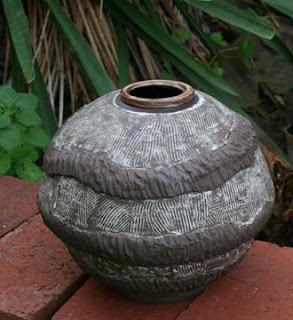ROPE POT
I had just finished making a perfectly round pot which
looked like a ball. I loved the process
and the result, so for this pot I started with the idea of making another “Ball
Pot” by making and putting together two hemispheres:
Unfortunately, the top section much larger than the bottom
section so I had to camouflage the discrepancy in their sizes. I used a big fat coil on the rim of the bottom
section, scored and dampened with magic water, then set the top section over it.
I pushed the coil up to the top section
and mushed (sorry, that’s a technical term you might not understand) everything
together well, but the coil still protruded. Below is a picture of this process
in process. “It looks…HIDEOUS!”

Actually I was somewhat “inspired” by the
contemporary modern work seen in the ceramics magazines, none of which I find
inspiring. I am put off by the
spontaneity of much of the work which to me indicates little thought and much
happenstance. It’s as if the artists
are taking a page from Jackson Pollock and letting the universe control or
determine the forms they present. I
taught art at the high school/middle school level and very much enjoyed the
students’ sudden appreciation of an event such as the colors of paint swirling
on the surface of water, or the forms created in clay when it drops on the
floor or they just throw it onto the table.
Oftentimes these forms are worthy of examination but rarely are they
worthy of being kept as a finished piece of artwork. While a piece of clay that looks like a
draped fabric is exciting in that the clay takes on the textures of the surface
onto which it has been pressed, it seems to me that it should then be
manipulated and controlled by the hand of a thoughtful and considerate artist
to create a pleasing form rather that left to lie where it landed and be bisque
fired. But since I always admire those
who have made the grade to be published, whether or not I agree with their
viewpoint, I decided to work in that vein and be more spontaneous. I rarely let my media be in control, but on
the few occasions I have I have been pleasantly surprised. Ever a former student in mind.
I decided to use the
bulge as a design element and wrapped a stick with string to make a
paddle. As I beat the join with the
paddle it created a texture that did camouflage the discrepancy in the sizes
between the two hemispheres, but it looked quite odd. I made another long coil and cut it in half
lengthwise and applied it to the body of the pot by scoring and using the Magic
Water, then beat the coils onto the surface of the pot to create the same
texture.
I had just read an article in October 2013 Ceramics Monthly
about pots made by Matt Repsher. He
treats the surface of his pots by scratching with a hacksaw then paints with
slip then scrapes with a fettling knife to leave slip only in the scratch
marks. His work was fascinating to me with its
textures and because of its pierced tracery.
I was anxious to try this
technique so I did it in the low spaces between the coils.

Above the pot is painted with slip from Laguna’s BMix
clay. My friends and I all laughed,
thinking it looks like an Oreo Cookie or some kind of gooey pastry! Below is a
photo of it after I scraped off most of the slip with a fettling knife.
Since the coils look like ropes after the beating with the
paddle I call it my “Rope Pot”. When it
is fired it will be a dark brown and I think I will leave it unglazed on the
outside. In photo below you will see how this clay
changes from the terra cotta color to almost black after a glaze firing.
Here is the final product:
Now, back to the drawing board.
Thanks for visiting!
ttfn










